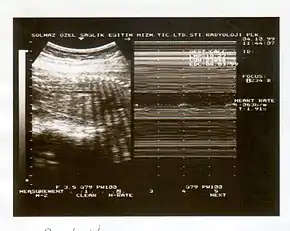Biophysical profile
A biophysical profile (BPP) is a prenatal ultrasound evaluation of fetal well-being involving a scoring system,[1] with the score being termed Manning's score.[2] It is often done when a non-stress test (NST) is non reactive, or for other obstetrical indications.
| Biophysical profile | |
|---|---|
 | |
| Synonyms | BPP |
| Purpose | prenatal evaluation ultrasound |
The "modified biophysical profile" consists of the NST and amniotic fluid index only.
Procedure
The BPP has 5 components: 4 ultrasound (US) assessments and an NST. The NST evaluates fetal heart rate and response to fetal movement. The five discrete biophysical variables:
- Fetal heart rate
- Fetal breathing
- Fetal movement
- Fetal tone
- Amniotic fluid volume
| Parameter | Normal (2 points) | Abnormal (0 points) |
|---|---|---|
| NST/Reactive FHR | At least two accelerations in 20 minutes | Less than two accelerations to satisfy the test in 20 minutes |
| US: Fetal breathing movements | At least one episode of > 30s or >20s[3] in 30 minutes | None or less than 30s or 20s[3] |
| US: Fetal activity / gross body movements | At least three discrete body/limb movement in 30 minutes (episodes of active continuous movement considered a single movement. | Less than three or two[3] movements |
| US: Fetal muscle tone | At least one[3] episode of active extension with return to flexion of fetal limb(s) or trunk, opening and closing of hand considered to be normal tone. | Either slow extension with return to partial flexion or movement of limb in full extension or absent fetal movement. |
| US: Qualitative AFV/AFI | At least one vertical pocket > 2 cm in the vertical axis or AFI of 5 cm | Largest vertical pocket </= 2 cm, or AFI </= 5 cm |
Use of vibroacoustic stimulation to accelerate evaluation has been described.[4]
Interpretation
Each assessment is graded either 0 or 2 points, and then added up to yield a number between 0 and 10. A BPP of 8 or 10 is generally considered reassuring. A BPP normally is not performed before the second half of a pregnancy, since fetal movements do not occur in the first half . The presence of these biophysical variables implies absence of significant central nervous system hypoxemia/acidemia at the time of testing. By comparison, a compromised fetus typically exhibits loss of accelerations of the fetal heart rate (FHR), decreased body movement and breathing, hypotonia, and, less acutely, decreased amniotic fluid volume.
| BPP | Recommended management |
|---|---|
| ≤2 | |
| 4 |
|
| 6 |
|
| ≥ 8 |
|
See also
References
- Lalor, J. G.; Fawole, B.; Alfirevic, Z.; Devane, D. (2008-01-23). "Biophysical profile for fetal assessment in high risk pregnancies". The Cochrane Database of Systematic Reviews (1): CD000038. doi:10.1002/14651858.CD000038.pub2. ISSN 1469-493X. PMC 7052779. PMID 18253968.
- Page 215, Chapter 39 on Biophysical Profile (BPP), in: Title: Diagnostic Ultrasound, Volume: 2, Issue: 1 of The Veterinary clinics of North America. Equine practice, Author: Norman W. Rantanen. Publisher: Jaypee Brothers Publishers, 1986. ISBN 9788184480641. Length: 261 pages
- "Biophysical Profile, Ultrasound: eMedicine Radiology". Retrieved 2009-12-29.
- Pinette MG, Blackstone J, Wax JR, Cartin A (June 2005). "Using fetal acoustic stimulation to shorten the biophysical profile". J Clin Ultrasound. 33 (5): 223–5. doi:10.1002/jcu.20116. PMID 16047387. S2CID 32503466.
- Intrauterine Growth Retardation. ROBERT C. VANDENBOSCHE, M.D., and JEFFREY T. KIRCHNER, D.O., Lancaster General Hospital, Lancaster, Pennsylvania. Am Fam Physician. 1998 Oct 15;58(6):1384-1390. "Archived copy" (PDF). Archived from the original (PDF) on 2013-05-13. Retrieved 2012-08-02.
{{cite web}}: CS1 maint: archived copy as title (link)